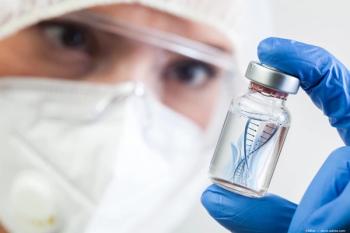
Causes of ocular inflammation linked to AAV gene therapy
Low-grade inflammation seems to be associated with baseline disease in inherited retinal dystrophies (IRDs), according to Christine N. Kay, MD, a surgeon at Vitreoretinal Associates, in Gainesville, Florida.
Low-grade inflammation seems to be associated with baseline disease in inherited retinal dystrophies (IRDs), according to Christine N. Kay, MD, a surgeon at Vitreoretinal Associates, in Gainesville, Florida.
Examples of XX include zonular instability in cataract surgeries resulting in intraocular lens dislocations in retinitis pigmentosa (RP), presence of anterior vitreous cells, cystoid macular edema in RP, and retinal antibodies in serum samples from patients with RP. A murine study found that inflammation preceded retinal degeneration in CNGB1 mice.1
Thus, it can be argued that patients with IRDs may be predisposed to inflammation, and adeno-associated virus (AAV)–based gene therapy in these patients may trigger severe inflammatory responses that can lead to permanent visual loss in some.
In phase 1/2 trials of gene therapy for RPE65-associated Leber congenital amaurosis, choroideremia, and RPGR-associated X-linked RP, ocular inflammation was dose-dependent, Kay pointed out, with patients receiving higher doses at higher risk for vitritis, retinitis, and choroiditis.2-4
“At . . . best . . . gene therapies treat disease and restore/rescue function,” Kay explained. “At worst . . . [they introduce] a new antigen and creat[e] a new problem.”
Inflammation culprits
Among the numerous factors that stimulate inflammation are delivery mode, vector/capsid manufacturing, promoters and transgene expression, surgical considerations, host characteristics, and dose (the most clinically relevant inflammation occurs with doses of 1 x 1011 vg/eye or higher).5
Delivery
The immune response varies according to the mode of administration (subretinal vs intravitreal). Most trials today evaluate vectors injected subretinally, whereas suprachoroidal injections are used less frequently.
“Intravitreal delivery . . . is [generally] more inflammatory than subretinal delivery and can lead to increased aqueous vector levels, increased systemic biodistribution to spleen/lymph nodes, [and] increased systemic dissemination from . . . anterior chamber [outflow],” Kay said. This dissemination, in turn, can trigger more “neutralizing antibody responses, which can interfere with effective transgene expression and lead to greater humoral responses and . . . reduced therapeutic efficacy.”
Vector/capsid manufacturing
Regarding the vector capsid serotype, baseline immunity can be species-dependent. Dose-dependent increases in binding and neutralizing antibodies after AAV injection and in increased serum levels of binding antibodies appear to be correlated with inflammation. But injection dose is the most important factor affecting increased serum antibody level.
In terms of the roles that vector design and manufacturing play in inflammation, we need to know more about the effects of the production platform (triple transfection in HEK293 cells and herpes- and baculovirus-based systems), of the empty capsid ratio (which correlates with increased transduction efficiency), and of process residuals and contaminants. Nevertheless, as previously noted, it is vector dose that correlates most closely with the inflammatory response.6
Promoters
A strong correlation has been observed between AAV toxicity and cis-regulatory sequences.7 As Xiong et al report, ubiquitous promoters (retinal pigment epithelial promoters) were more toxic than photoreceptor-specific promoters. The reason may be that ubiquitous promoters drive higher levels of transgene expression in more cell types.
Surgical considerations
Surgical delivery of AAV plays a role in inflammation. Proinflammatory factors of surgery include variability in bleb size, location, and dilution with BSS; surgery-related adverse events (particularly hemorrhage); operative duration; and vitreous egress of the vector.
Host characteristics
These include patient age, pigmentation, immune system hyperactivity, human leukocyte antigen type, and neutralizing antibodies. AAV can immediately activate innate pattern recognition receptors that lead to the release of inflammatory cytokines and type I interferons. A delayed (adaptive) immune response occurs days or weeks after innate immunity. A cellular response can result in increased T cells and a humoral response in increased B cells, plasma cells, and antibodies.
Takeaways
In the battle between AAV and the immune system, these are the important points to remember.
Although inflammation is par for the course in ocular gene therapy, ophthalmologists rarely discuss it.
Inflammation occurs with subretinal as well as intravitreal injections.
It may be subtle (subretinal deposits seen on an OCT) and may be correlated with loss of therapeutic efficacy.
It is typically dose-dependent, can manifest in multiple ways, and can occur and recur in adults.
Preventing inflammation should be the goal because once it develops, treatment can be difficult and require long-term management and extensive interventions.
Optimization of capsid design for low empty capsid ratio, a clean manufacturing profile, and promoter choice are needed.
Intelligent and target-specific choice of immunosuppressant management including general agreement on corticosteroid use, alternative steroid-sparing immunosuppression if a specific therapy requires long-term management, and use of periocular steroid injection seems to become routine in subretinal trials, but with potential accompanying risks of cataract and glaucoma.
Because “our primary responsibility as physicians is to do no harm . . . we need to acknowledge inflammation in AAV-based gene therapy . . . discuss it, and learn . . . to control it,” Kay concluded.
Christine N. Kay, MD
This article was adapted from Christine Kay’s presentation at the 25th annual meeting of the American Society of Gene & Cell Therapy in May 2022. Kay is an investigator for and consultant to numerous companies involved in retinal gene therapy research.
References
1. Blank T, Goldmann T, Koch M, et al. Early microglia activation precedes photoreceptor degeneration in mouse model of CNGB1-linked retinitis pigmentosa. Front Immunol. 2018;8:1930-1940. doi:10.3389/fimmu.2017.01930
2. Bainbridge JWB, Mehat MS, Sundaram V, et al. Long-term effect of gene therapy on Leber’s congenital amaurosis. N Engl J Med. 2015;372:1887-1897. doi:10.1056/NEJMoa1414221
3. Xue K, Jolly JK, Barnard AR, et al. Beneficial effects on vision in patients undergoing retinal gene therapy for choroideremia. Nat Med. 2018;24(10):1507-1512. doi:10.1038/s41591-018-0185-5
4. Cehaic-Kapetanovic J, Xue K, Martinez-Fernandez de la Camara C, et al. Initial results from a first-in-human gene therapy trial on X-linked retinitis pigmentosa caused by mutation in RPGR. Nat Med. 2020;26(3):354-359. doi:10.1038/s41591-020-0763-1
5. Bucher K, Rodríguez-Bocanegra E, Dauletbekov D, et al. Immune responses to retinal gene therapy using adeno-associated viral vectors—implications for treatment success and safety. Prog Retin Eye Res. 2021;83:100915. doi:10.1016/j.preteyeres.2020.100915
6. Timmers AM, Newmark JA, Turunen HT, et al. Ocular inflammatory response to intravitreal injection of adeno-associated virus vector: relative contribution of genome and capsid. Hum Gene Ther. 2020;31(1-2):80-89. doi:10.1089/hum.2019.144
7. Xiong W, Wu DM, Xue Y, et al. AAV cis-regulatory sequences are correlated with ocular toxicity. Proc Natl Acad Sci USA. 2019;116(12):5785-5794. doi:10.1073/pnas.1821000116
Newsletter
Don’t miss out—get Ophthalmology Times updates on the latest clinical advancements and expert interviews, straight to your inbox.





